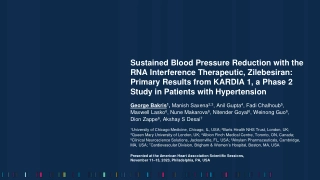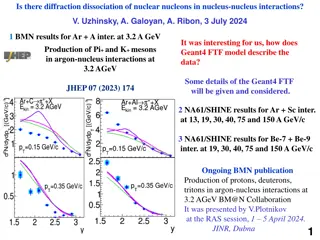
Understanding Triangulated Graphs and Recognition Algorithm
Explore the concept of triangulated graphs including properties like perfect elimination orderings and simplicial nodes. Learn about the algorithm for recognizing triangulated graphs and finding maximal cliques efficiently. Discover how deleting nodes in a triangulated graph preserves its structure and more.
Download Presentation

Please find below an Image/Link to download the presentation.
The content on the website is provided AS IS for your information and personal use only. It may not be sold, licensed, or shared on other websites without obtaining consent from the author. If you encounter any issues during the download, it is possible that the publisher has removed the file from their server.
You are allowed to download the files provided on this website for personal or commercial use, subject to the condition that they are used lawfully. All files are the property of their respective owners.
The content on the website is provided AS IS for your information and personal use only. It may not be sold, licensed, or shared on other websites without obtaining consent from the author.
E N D
Presentation Transcript
Algorithmic Graph Theory Triangulated Graphs Perfect Elimination Ordering 2
Triangulated Graphs G triangulated G has the triangulated graph property Every simple cycle of length l > 3 possesses a chord. Triangulated graphs, or Chordal graphs, or Perfect Elimination Graphs 3
Triangulated Graphs c b d a c c d b f e b d g f e a e a G2 G G 3 1 4
Triangulated Graphs Dirac (1961) and later Lekkerkerker and Boland (1962) proved that: A triangulated graph always has a simplicial node, a node all of whose neighbors form a clique. a simplicial nodes non siplicial a, c, f b, d, e e b d f c Fulkerson and Gross [1965] (also Rose) gave useful algorithmic characterization. 5
Triangulated Graphs It follows easily from the triangulated property that: deleting nodes of a triangulated graph yields another triangulated graph. a a a e e b b b d d d f f c f c 6
Triangulated Graphs Recognition Algorithm This observation leads to the following easy and simple recognition algorithm: Find a simplicial node of G; Delete it from G, resulting G ; Recourse on the resulting graph G , until no node remain. 7
Triangulated Graphs If G contains a Ck, k 4, no node in that cycle will ever become simplicial. Triangulated Non-triangulated 8
Triangulated Graphs The algorithm provides us with all the maximal cliques. Let C(vi) = vi {vj : vj higher neighbor of vi}. Then, C(vi) = clique C(a) = {a, b, e} C(b) = {b, c, d, e} C(c) = {c, d, e} C(d) = {d, e, f} C(e) = {e, f} C(f) = {f} a e b f c d The set of cliques C(vi), 1 i n , includes all the maximal cliques. 9
Triangulated Graphs Note that some cliques C(vi) are not maximal. a C(a) = {a, b, e} C(b) = {b, c, d, e} C(c) = {c, d, e} C(d) = {d, e, f} C(e) = {e, f} C(f) = {f} e b f c d 10
Triangulated Graphs Theorem. There are at most n maximal cliques in a chordal graph on n nodes. Max cliques 7 Number of nods 6 The node-ordering provided by the algorithm has many other uses. a e b (a, c, b, e, d) (c, d, e, a, b) (c, a, b, d, e) d c 11
Triangulated Graphs Node-ordering : perfect elimination ordering, or perfect elimination scheme a e b (a, c, b, e, d) (c, d, e, a, b) (c, a, b, d, e) d c Rose establishes a connection between triangulated graphs and symmetric linear systems 12
Triangulated Graphs Let = v1,v2, ...,vn be an ordering of the vertices of a graph G = (V, E) is a peo, if each vi is a simplicial node to graph G vi,vi+1, ,vn a a e b e b = (c, d, e, a, b) d c d 13
Triangulated Graphs is a peo if each vi is a simplicial node to graph G vi,vi+1, ,vn . That is, Xi= vj adj (vi) i < j is complete. b d a c c G2 f e b d G1 g f e a = 1, 7, 2, 6, 3, 5, 4 no simplicial vertex G1 has 96 different peo. 14
Algorithmic Graph Theory Algorithm LexBFS Algorithm MCS 15
Computing PEO - LexBFS Algorithm LexBFS 1. for all v V do label(v) : = () ; 2. for i : = V down to 1 do label (u) label (u) || i end 2.1 choose v V with lexmax label (v); 2.1 (i) v; 2.3 for all u V N(v) do 2.4 V V \ v ; 16
Computing PEO - LexBFS c Algorithm LexBFS d b (An example) e a 17
Computing PEO - LexBFS c c c c c 1 d d d b d d b b b b 4 3 4 3 4 3 4 2 2 5 5 5 5 5 e e e a e e a a a a = a = e, d, b, a = d, b, a = b, a = c, e, d, b, a L(c) = (321) L(b) = (4) L(c) = () L(d) = (4) L(e) = (4) L(c) = (32) L(e) = (432) L(c) = (3) L(d) = (43) L(e) = (43) 18
Algorithms for Computing PEO Algorithm MCS 1. for i : = V down to 1 do numbered neighbours; end 1.1 choose v V with max number of 1.2 number v by i; 1.3 (i) v; 1.4 V V \ v ; 19
Computing PEO - MCS c Algorithm MCS d b (An example) e a 20
Computing PEO - MCS c c c c c 2 2 d d d b d d b b b b 4 3 4 3 4 3 4 1 5 5 5 5 5 e e e a e e a a a a = a = e, d, b, a = d, b, a = b, a = c, e, d, b, a 21
Computing PEO - Complexity Algorithms LexBFS & MCS 22
Algorithmic Graph Theory Algorithm PERFECT Correctness & Complexity 23
Testing a PEO Algorithm PERFECT Algorithm PERFECT for all vertices u do A(u) ; 2. for i 1 to n-1 do 3. v (i); 4. Xv x adj(v) | -1(v) < -1(x) ; 5. if Xv = then goto 8 6. u (min -1(x) x Xv ); 7. A(u) A(u) Xv- u 8. if A(v) - adj (v) then return ( false ) 9. end 10. return ( true ) Naive Algorithm O(n3) 1. This Algorithm O(n+m) A(v) adj(v) true 24
Testing a PEO Algorithm PERFECT v A(u) = x, y u A(u) - adj(u) v u x y A(u) x,y Initially: A(a) = A(e) = A(b) = = v=a Xv = e, b} u=e A(e)= b A(a) - adj(a) = v= e Xv = b, d u= b A(b) = d A(e) - adj(e) = v u x y A(u) - adj(u) = c b d e a = [a,e,b,d,c] 25
Testing a PEO Algorithm PERFECT Example (a): = [1, 2, 3, 4, 5, 6, 7, 8] v = 1: Xv={3,4,8} v = 2: Xv={4,7} v = 3: Xv={4,5,8} v = 4: Xv={5,7,8} v = 5: Xv={6,7,8} v = 6: Xv={7,8} u = 3 A(3)={4,8} u = 4 A(4)={7} u = 4 A(4)={7,5,8} A(3) - adj(3) u = 5 A(5)={7,8} A(4) - adj(4) u = 6 A(6)={7,8} A(5) - adj(5) u = 7 A(7)={8} A(6) - adj(6) A(1) - adj(1) A(2) - adj(2) 26
Correctness of Algorithm PERFECT Theorem: The algorithm PERFECT returns TRUE iff is a peo Proof : ( ) Suppose that the algorithm returns FALSE during the -1(u)-th iteration. This may happen only if in line 8: A(u) - adj(u) Thus, w A(u) such that w adj(u) 27
Correctness of Algorithm PERFECT A(u) - adj(u) w A(u) and w adj(u) The algorithm returns FALSE if and only if vertices v, u, w : -1(v)< -1(u)< -1(w), where u is define in line 6 during the -1(v)-th iteration, and u, w Adj(v) but w adj(u) v u x w Clearly, since (u,w) E is not peo. 28
Correctness of Algorithm PERFECT ( ) Suppose is not a peo and the Algo PERFECT returns TRUE. Let v be a vertex with max index in , such that Xv= w w adj(v) and -1(v) < -1(w) is not complete = [ v, . ..... ..] max i.e., v is the first vertex from right to left in s.t Xv does not induce a clique 29
Correctness of Algorithm PERFECT Let u be a vertex of set Xv defined during the -1(v)-th iteration (in line 6), after which (in line 7) Xv-{u} is added to A(u) 1st neighbor = [ v, ..,u, ..] 30
Correctness of Algorithm PERFECT = ( , v, , u, ..) A(u) X - {u} v u max v Since the Algorithm PERFECT returns TRUE A(u) - adj(u) = (in line 8) x X - {u} v Xv-{u} adj (u) Thus, (i) every x Xv -{u} is adjacent to u. 31
Correctness of Algorithm PERFECT = ( , v, , u, ..) A(u) X - {u} v u max v (i) every x Xv -{u} is adjacent to u. y x and X - {u} v (ii) every x, y Xv -{u} is adjacent. Statement (ii) follows since v is the vertex with max index in such that Xv is not complete Thus, Xv is complete, a contradiction! 32
Algorithmic Graph Theory Chromatic Number Clique Number - Max Clique Stability Number (G) 33
X X and Maximal Cliques Fulkerson and Gross (1965) pointed out that: Every maximal clique of a triangulated graph G is of the form {u} Xu where Xu = { x adj(u) -1(u) < -1(x) } Proposition (Fulkerson and Gross, 1965): A triangulated graph on n nodes has at most n maximal cliques, with equality iff the graph has no edges. 34
X X and Maximal Cliques Algorithm Maximalcliques Some of {u} Xuwill not be maximal clique; {u} Xuis not maximal clique if and only if for some i, in line 7 of Algorithm PERFECT, Xu = Xv- u is concatenated to A(u); {u} Xu 1, 2, , i, Xu u v 7. A(u) A(u) Xv- u 35
X X and Maximal Cliques Example (a): {1} X1 ={1,6,7,8} {2} X2 ={2,5,6} {3} X3 ={3,5} {4} X4 ={4,8} {5} X5 ={5,6,7} = [1, 2, 3, 4, 5, 6, 7, 8] {6} X6 ={6,7,8} {7} X7 ={7,8} {8} X8={8} maximal non maximal 36
X X and Maximal Cliques Example (b): = [1, 2, 3, 4, 5, 6, 7, 8] {6} X6={6,7,8} is not maximal clique, since X6 is concatenated to A(6) o X6={7,8} o There exists vertex v = 1, such that: o (lines 3-6) v = 1, X1={6,7,8} and u = 6 o (line 7) X1-{6} is concatenated to A(u) o X1-{6} = {7,8} = X6 is concatenated to A(6) 37
X X and Maximal Cliques Example (c): = [1, 2, 3, 4, 5, 6, 7, 8] {7} X7 ={7,8} is not maximal clique, since X7 is concatenated to A(7) o X7={8} o There exists vertex v = 6, such that: o (lines 3-6) v = 6, X6={7,8} and u = 7 o (line 7) X6-{7} is concatenated to A(u) o X6-{7} = {8} = X7 is concatenated to A(7) 38
Algorithm X X and Maximal Clique S(v) indicates the size of the largest set that would have been concatenated to A(v) in Algorithm PERFECT. clique( ) X 1; S(v) 0 v V; 1. for i 1 to n do 2. v (i) 3. Xv {x adj(v) -1(v) < -1(x) } 4. if adj(v) = then print {v}; 5. u (min -1(x) x Xv ); 6. if Xv = then goto 9 7. S(u) max{S(u), Xv -1} 8. if S(v) < Xv then do : print {v} Xv 9. end return X X = max {X, 1+ Xv } 39
Coloring Chordal Graphs Gavril (1972) gives a coloring algorithm, based on a greedy approach. We use positive integers as colors. Method: Start at the last node vn of the peo; Work backwards, assign to each vi in turn the minimum color not assigned to its higher neighbors. 40
Coloring Chordal Graphs Example: = [a, c, b, d, e, f] 3 1 2 3 21 (G) = (G) 41
Finding the Stability Number (G) Gavril (1972) gives the following solution: Method: Let be a peo of a chordal graph G; Define inductively a sequence of vertices v1, v2, , vtas follows: o v1= (1); o vi is the first vertex in which (i) follows vi-1 and (ii) is not in Xv1 Xv2 Xvi-1; Recall that, all vertices following vt are in Xv1 Xv2 Xvt 42
Finding the Stability Number (G) Example: = [a, c, b, d, e, f] v3 v1v2 Xv1= {b, f} Xv2= {d} Xv3= {} 43
Finding the Stability Number (G) Theorem: The set {v1, v2, , vt} is a maximum stable set of G, and the collection of sets Yi = {vi} Xvi, 1 i t, comprises a minimum clique cover of G. Proof. The set {v1, v2, , vt } is stable since if (vj, vi) E for j < i, then vi Xvj which cannot be. Thus, (G) t. 44
Finding the Stability Number (G) On the other hand, each of the sets Yi= {vi} Xvi is a clique, and so {Y1, , Yt} is a clique cover of G. Thus, (G) = (G) = t. We have produced the desired maximum stable set and minimum clique cover. 45
Algorithmic Graph Theory Vertex Separators Characterizations 46
Characterizing Triangulated Graphs Definition: A subset S of vertices is called a Vertex Separator for nonadjacent vertices a, b or, equivalently, a-b separator, if in graph GV-Svertices a and b are in different connected components. If no proper subset of S in an a-b separator, S is called Minimal Vertex Separator. 47
Characterizing Triangulated Graphs Example 1: p z q x y r The set {y, z} is a minimal vertex separator for p and q. 48
Characterizing Triangulated Graphs Example 2: p x z q y r The set {x, y, z} is a minimal vertex separator for p and r (p-r separator). . 49
Characterizing Triangulated Graphs Theorem (Dirac 1961, Fulkerson and Gross 1965) (1) G is triangulated. (2) G has a peo; moreover, any simplicial vertex can start a perfect order. (3) Every minimal vertex separator induces a complete subgraph of G. GA S GB y b1 ar Proof: (1) (3) a b x a1 bk 50







